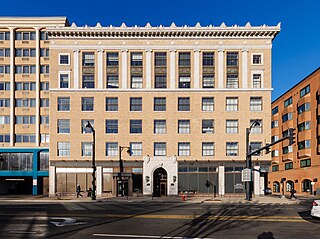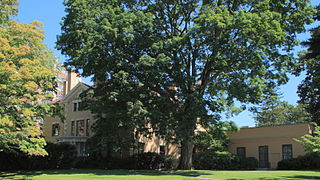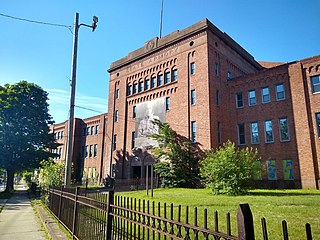
The Windsor Avenue Congregational Church is a historic church at 2030 Main Street in Hartford, Connecticut. The brick Romanesque Revival-style church building, completed in 1872, now houses Faith Congregational Church, whose lineage includes the city's oldest African-American congregation, established in 1819. The church is a stop on the Connecticut Freedom Trail and was listed on the United States National Register of Historic Places in 1993.

The R. and F. Cheney Building, also known as the Brown Thomson Building, is a commercial building designed by noted American architect H. H. Richardson. It is located at 942 Main Street, Hartford, Connecticut, and is now on the National Register of Historic Places.

The Old Killingly High School is a historic school building on 185 Broad Street in the Danielson section of Killingly, Connecticut. Built in 1908 and enlarged in 1927, it served as the town's high school until 1965, and then its junior high school until 1990. It is a significant local example of Renaissance and Colonial Revival architecture, designed by Hartwell, Richardson & Driver. It was listed on the National Register of Historic Places in 1992. It now houses the Killingly Police Department.

The Fort Washington Avenue Armory, also known as the Fort Washington Armory, The Armory, and the 22nd Regiment Armory, is a historic 5,000-seat arena and armory building located at 216 Fort Washington Avenue, between West 168th and 169th Streets, in the Washington Heights neighborhood of Manhattan, New York City. It is a brick Classical Revival building with Romanesque Revival elements, such as the entrance arch, and is currently home to the non-profit Armory Foundation, National Track and Field Hall of Fame, Nike Track and Field Center, and other organizations including the Police Athletic League of New York City.

The Fourth Congregational Church, also known historically as the Horace Bushnell Congregational Church and now as the Liberty Christian Center International, is a historic church at Albany Avenue and Vine Street in Hartford, Connecticut. The church building was built in 1913-14 using parts of an older Greek Revival church, and was listed on the National Register of Historic Places in 1982 for its architecture and role in local historical preservation efforts.

Temple Beth Israel, sometimes called Charter Oak Temple, is an historic former Reform Jewish synagogue and later church building, now cultural center, located at 21 Charter Oak Avenue, in Hartford, Connecticut, in the United States.

The High Street Historic District of Hartford, Connecticut is a 1.1-acre (0.45 ha) historic district that includes three buildings typifying the architectural styles of the late 19th and early 20th centuries in the city. It was listed on the National Register of Historic Places in 1998. The buildings are located at 402-418 Asylum Street, 28 High Street, and 175-189 Allyn Street, and includes the Batterson Block and Judd and Root Building, each individually listed for their architecture.

The South Green Fire Station, also known as the Engine Company 1 Fire Station, is at 197 Main St. in downtown Hartford, Connecticut. Built in 1927, it is an architecturally distinctive example of Classical and Collegiate Gothic Revival architecture, designed by a prominent local firm. The station, as well as the former fire equipment maintenance house behind it at 36 John Street, were listed on the National Register of Historic Places in 1989. The station presently houses Engine Company 1 and Ladder Company 6 of the Hartford Fire Department.

The Engine Company 2 Fire Station is a firehouse at the corner of Main and Belden streets in Hartford, Connecticut, United States. It is a brick structure built in the early 20th century, the second firehouse built for the company. Architect Russell Barker, who designed many public buildings in the city, used the Italian Renaissance Revival style, unusual for a firehouse. The front facade boasts intricate brickwork. It is one of two remaining firehouses in the city originally designed to accommodate both men and horses. In 1989, it was added to the National Register of Historic Places along with several other city firehouses. It continues to serve its original function, housing Engine Company 2 of the Hartford Fire Department.

The Engine Company 6 Fire Station is a former Hartford Fire Department firehouse located at 34 Huyshope Avenue in Hartford, Connecticut. Built in 1937, it is a well-preserved example of a Moderne style fire station, and served as such until 1984. The building was listed on the National Register of Historic Places on March 2, 1989. It now houses a homeless shelter.

The Weiss Center, formerly the U.S. Post Office-Manchester Main is a historic building at 491 Main Street in Manchester, Connecticut. It was built in 1931 and was listed on the National Register of Historic Places in 1986 for its architecture. It includes Colonial Revival, Classical Revival, and Georgian Revival architectural features.

The U.S. Post Office-Milford Main, also known as Milford Main Post Office, is a historic post office building at 6 West River Street in Milford, Connecticut. It is a red brick building, trimmed with limestone, that was designed by James A. Wetmore and completed in 1931. It is a fine local example of Classical Revival design, making a significant contribution to a cluster of civic buildings around a triangular park north of Milford's commercial district. The building was listed on the National Register of Historic Places in 1986.

Buford Tower is a tower standing along the north shore of Lady Bird Lake in downtown Austin, Texas. The structure was originally built in 1930 as a drill tower for the Austin Fire Department, but it now serves as a bell tower and landmark. Named after fire department Captain James L. Buford, the structure has been listed on the National Register of Historic Places since 2016.

Footguard Hall was the headquarters and armory of the First Company Governor's Footguard of the state Connecticut, a ceremonial military company founded in 1771 and originally tasked with protecting the governor and state legislature. The hall is located at 159 High Street, in Hartford, Connecticut, in a Romanesque Revival brick building built in 1888. The building was listed on the National Register of Historic Places in 1984 in recognition of the organization's history and its distinctive architecture. The First Company Governor's Footguard now uses the Governor William A. O'Neill State Armory at 360 Broad Street, Hartford, Connecticut.

The Hartford Electric Light Company Maple Avenue Sub-Station is a historic industrial and commercial building at 686 Maple Avenue in Hartford, Connecticut. Built in 1926, it is a fine example of Classical Revival architecture designed by noted local architects, and a reminder of the history of the area's electrification. It was listed on the National Register of Historic Places in 2000, and has been converted into commercial use.

The Lyman House is a historic house at 22 Woodland Street in Hartford, Connecticut. It was built in 1895 for Theodore Lyman, a prominent local lawyer and corporate director. Since 1925 it has been home to the Town and County Club, a private women's club. A well-preserved example of Classical Revival architecture, it was listed on the National Register of Historic Places in 1975.

The Vine Street Apartment Buildings, many now known as the Horace Bushnell Apartments, are a historic collection of residential apartment blocks at 4-48 Vine Street in Hartford, Connecticut. Built between 1922 and 1925, they consist of eleven brick buildings sharing massing, scale, and setting, with a cross-section of period building styles. They were listed on the National Register of Historic Places in 2012.

The Orange Armory is a historic armory building at 135 East Main Street in Orange, Massachusetts, United States. Built in 1913, it served as an organizing and station point for volunteer forces in World War I, and for state militia units into the 1960s. It was listed on the National Register of Historic Places in 2020.

The New Haven Armory is a historic building at 270–290 Goffe Street in the Dixwell neighborhood of New Haven, Connecticut, United States. Developed between 1928 and 1930, the armory served the Connecticut National Guard and the Second Company Governor's Foot Guard. It has also served as a venue for concerts, events, and other civic functions in the community.

The First Battery Armory, also known as the 102nd Medical Armory and the State Armory, is a historic National Guard armory building at 56 West 66th Street, between Central Park West and Columbus Avenue, on the Upper West Side of Manhattan in New York City, United States. The building was constructed between 1901 and 1904 and was designed by Arthur J. Horgan and Vincent J. Slattery in multiple revival architectural styles. It is composed of a symmetrical brick-and-granite headhouse to the north and a drill hall to the south. The armory is a New York City designated landmark and is listed on the National Register of Historic Places.























